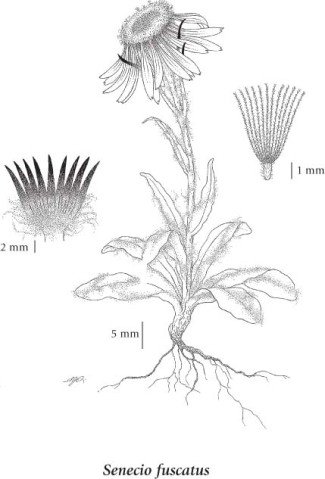Tephroseris lindstroemii (Ostenf.) Á. Löve & D. Löve
northern groundsel
Asteraceae (Aster family)
Introduction to Vascular Plants
northern groundsel
Asteraceae (Aster family)
Introduction to Vascular Plants
Photograph
© Alfred Cook (Photo ID #8358)
Species Information
General:
Perennial herb from a short, rhizome-like woody stem-base; stems erect, solitary or few, simple or rarely few-branched above, white woolly-hairy becoming long-hairy with whitish or yellowish multicellular hairs above, 3-30 cm tall.
Leaves:
Basal leaves thickish, oblanceolate to egg-shaped, stalked, 2-10 cm long including short stalks, 3-35 mm wide, often irregularly toothed, woolly-hairy or these hairs deciduous and underlain with flattened multicellular hairs; stem leaves similar, gradually reduced upwards, lanceolate to oblong, sometimes toothed, woolly as in the basal leaves, unstalked.
Flowers:
Heads with ray and disk flowers, solitary or rarely 2-4 at the ends of branches on densely white-woolly stalks with yellowish multicellular hairs; involucres 6-12 mm tall; involucral bracts linear to lance-shaped, purplish throughout, woolly to hairless or hairy with yellowish multicellular hairs; bracteoles lacking; ray flowers orange-yellow, mostly 8-25 mm long.
Fruits:
Achenes oblong, nerved, stiff-hairy; pappus of white hairlike bristles.
Notes:
Although T.M. Barkley previously considered S. fuscatus as synonymous with the E Asian S. tundricola (Douglas 1982), he recently (Barkley 1994) excluded the latter from the North American flora and resurrected S. fuscatus.
Illustration

If more than one illustration is available for a species (e.g., separate illustrations were provided for two subspecies) then links to the separate images will be provided below. Note that individual subspecies or varietal illustrations are not always available.
Illustration Source: The Illustrated Flora of British Columbia
Ecology
Ecological Framework for Tephroseris lindstroemii
The table below shows the species-specific information calculated from
original data (BEC database) provided by the BC Ministry of Forests and Range.
(Updated August, 2013)
The table below shows the species-specific information calculated from
original data (BEC database) provided by the BC Ministry of Forests and Range.
(Updated August, 2013)
| Site Information |
Value / Class |
||
|
Avg |
Min |
Max |
|
| Elevation
(metres) |
1562 | 1450 | 1675 |
| Slope
Gradient (%) |
17 | 0 | 35 |
|
Aspect (degrees) |
149 | 150 | 150 |
| Soil
Moisture Regime (SMR) [0 - very xeric; 4 - mesic; 8 - hydric] |
4 | 3 | 6 |
| Modal
Nutrient Regime
Class |
B | ||
| #
of field plots species was recorded in: |
2 | ||
| Modal
BEC Zone Class |
SWB | ||
|
All BEC Zones (# of stations/zone) species was recorded in |
BAFA(1), SWB(1) | ||
|
Source:
Klinkenberg 2013
|
|||
Habitat and Range
Dry rocky fellfields and slopes in the alpine zones; rare in extreme NW BC; N to AK, YT and NT, disjunct in MT and WY.Status Information
Synonyms
Synonyms and Alternate Names:
Senecio bivestitus Cronquist
Senecio fuscatus auct. non Hayek
Senecio lindstroemii (Ostenf.) A.E. Porsild
Senecio tundricola auct. non Tolm.
Tephroseris tundricola var. lindstroemii (Ostenf.) V. Yu.